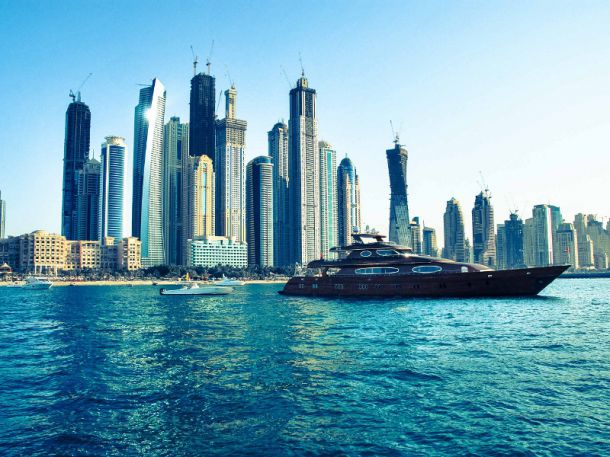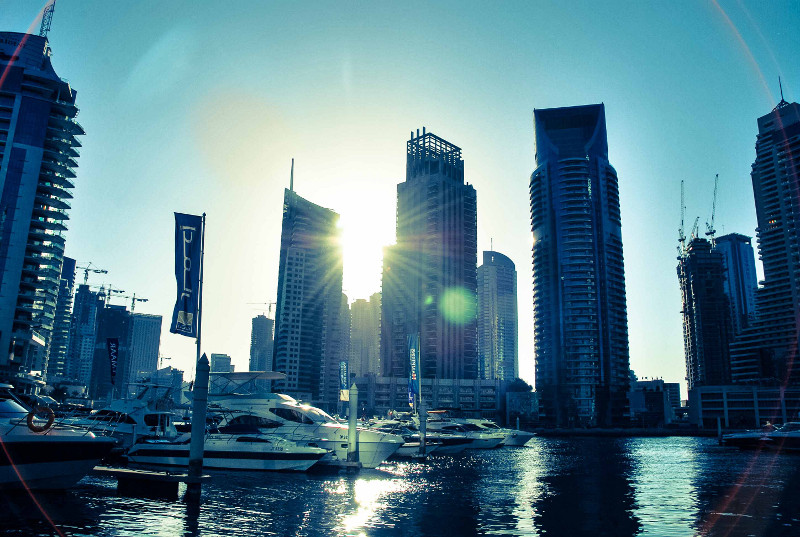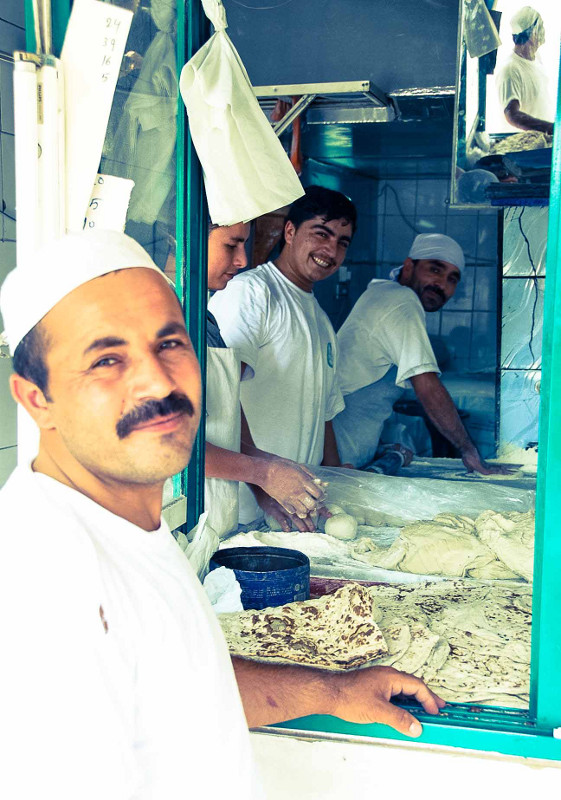
Having lived in New York for almost eight years, I sometimes wonder why there seems to be a constant need to reinvent the city and why we need even more high-rises. The planned extension on the West Side of Manhattan, the rise of the new World Trade Center complex and, suggestions to rezone Midtown East and permit new high-rise buildings close to the landmarked Grand Central leaves some of us wondering: Don’t we have enough? Why is new and taller better? My recent trip to Dubai taught me that we shouldn’t so much look at what we already have, but at what others have – and what we should be doing to remain competitive on a global scale. It was my first journey to Dubai and the Middle East. An 11 ½ hour flight can be daunting (not to mention the 13 ½ hour return leg) but once I stepped into Emirates Airlines’ brand new A 380 I was actually quite surprised that I didn’t mind the long journey. After all, who can complain with that much legroom in economy, an attentive staff and – most importantly – an entertainment system that enabled me to catch up on several Oscar nominated films. Once I got into Dubai’s international airport, I couldn’t stop comparing the experience to arriving at international airports in the U.S., especially Newark and JFK.
Instead of grayish tubes that lead you to an unwelcoming arrivals hall with long lines, Dubai greets visitors with bright lights and indoor palm trees. A state of the art air train swooshes visitors to the arrival area, where my immigration process was a breezy 10 minutes instead of the 45 minutes it usually takes me to pass immigration when I enter the U.S. The luggage carousels were as brand new as the signs and ads throughout the entire airport. The only downside of traveling on an airbus 380 on Emirates Airlines: everyone is allowed to check in 2 pieces of so it takes a while to unload the approximately 1600 suitcases. My first impression during my nighttime trip through Dubai was that I felt catapulted into the future – a city of the 22nd century. The sheer size of the city felt much larger than the 1.7 million estimated inhabitants of Dubai – and no wonder: Dubai ranks among the top 10 tourist destinations worldwide and – according to an index released by global credit card company MasterCard – the emirate is expected to have attracted 8.8 million international visitors in 2012 with spending estimated at around $8.8 billion. On that same index, New York comes in at number 13 with 7.6 million visitors – the good (or in some cases bad) news: New York’s visitors spent a healthy $ 19.6 billion in 2012. The difference of the spending may well lie in missing cultural institutions – Dubai does not have Broadway style show, hundreds of museums, or many of the other attractions that New York tourists spend money on during their visit. I was staying in the Marina area of Dubai, the recent development along the water about 40 minutes from the airport. and when I woke the next morning I was greeted by the sight of hotels and high-end resorts spread along a beautiful stretch of white sand and crystal blue waters. Unsure of what I needed to wear for my first trip to the beach, I decided for a long-sleeved dress. It seemed unnecessary, as the mix of Russian and European tourists in Miami-style beach outfits happily mingled with local families, covered and veiled. To me it looked like a global melting pot similar to New York. To be sure, the U.A.E.’s legal system still forbids public signs of affection like kissing and holding hands, unmarried couples are not allowed to live together, and adultery is being punished as a crime. However, on the surface, these restrictions were not visible in the beach areas at all.The building and restaurant scene reminded me of Las Vegas in the middle of a building boom. The trip to the beach was somewhat adventurous, as a completely new resort-style low-rise area was being built in front of the “older” (read 10 year old) structures like the Sheraton and Hilton. The tourists didn’t seem to mind the construction sites, as cranes and bulldozers are a common site all over this expanding city. In the past decades, Dubai has become known for its successful building projects, including: The Burj Al Arab, the world’s tallest freestanding hotel; the Palm Islands, a construction of three artificial islands in the shape of the date palm on which residential and commercial property are built; and The World Islands, a massive man-made archipelago of 300 islands in the shape of the world. Not to forget the Burj Khalifa, the world’s tallest man-made structure. During the week I stayed in Dubai, a brand new 6.3 million square foot island development 500m off the coast of Dubai was announced. Once completed, Jumana Island is supposed to be home to yet more upcoming luxury resorts, apartments, beachfront homes, and a private marina. The new island city will also feature a 688-foot Ferris Wheel to be named the Dubai Eye (London watch out!). This new island will be an addition to the already burgeoning development of the city, which was really only built out in 1966 after the discovery of oil. Though it’s seen some bumps in the road, such as in 2009 when Dubai had be bailed out by its neighbors with $10 billion, the emirate has, all-in-all, been extraordinarily successful.The success of Dubai? Obviously the money associated with the discovery of oil helped to build out the amazing infrastructure and building boom. But beyond these infrastructure initiatives, the city was quick to realize in the past decade, that oil will vanish one day and they must think ahead – even decades ahead – to remain competitive. Not wanting to rely on tourism alone, Dubai has been building out several clusters of free zones, including: Dubai Internet City, an internet technology area with ownership and tax related benefits; Dubai Media City, a tax-free zone to increase Dubai’s presence in the worldwide media; and Dubai Maritime City which will have many new maritime facilities, including waterfronts and harbors.
I was staying in the Marina area of Dubai, the recent development along the water about 40 minutes from the airport. and when I woke the next morning I was greeted by the sight of hotels and high-end resorts spread along a beautiful stretch of white sand and crystal blue waters. Unsure of what I needed to wear for my first trip to the beach, I decided for a long-sleeved dress. It seemed unnecessary, as the mix of Russian and European tourists in Miami-style beach outfits happily mingled with local families, covered and veiled. To me it looked like a global melting pot similar to New York. To be sure, the U.A.E.’s legal system still forbids public signs of affection like kissing and holding hands, unmarried couples are not allowed to live together, and adultery is being punished as a crime. However, on the surface, these restrictions were not visible in the beach areas at all.The building and restaurant scene reminded me of Las Vegas in the middle of a building boom. The trip to the beach was somewhat adventurous, as a completely new resort-style low-rise area was being built in front of the “older” (read 10 year old) structures like the Sheraton and Hilton. The tourists didn’t seem to mind the construction sites, as cranes and bulldozers are a common site all over this expanding city. In the past decades, Dubai has become known for its successful building projects, including: The Burj Al Arab, the world’s tallest freestanding hotel; the Palm Islands, a construction of three artificial islands in the shape of the date palm on which residential and commercial property are built; and The World Islands, a massive man-made archipelago of 300 islands in the shape of the world. Not to forget the Burj Khalifa, the world’s tallest man-made structure. During the week I stayed in Dubai, a brand new 6.3 million square foot island development 500m off the coast of Dubai was announced. Once completed, Jumana Island is supposed to be home to yet more upcoming luxury resorts, apartments, beachfront homes, and a private marina. The new island city will also feature a 688-foot Ferris Wheel to be named the Dubai Eye (London watch out!). This new island will be an addition to the already burgeoning development of the city, which was really only built out in 1966 after the discovery of oil. Though it’s seen some bumps in the road, such as in 2009 when Dubai had be bailed out by its neighbors with $10 billion, the emirate has, all-in-all, been extraordinarily successful.The success of Dubai? Obviously the money associated with the discovery of oil helped to build out the amazing infrastructure and building boom. But beyond these infrastructure initiatives, the city was quick to realize in the past decade, that oil will vanish one day and they must think ahead – even decades ahead – to remain competitive. Not wanting to rely on tourism alone, Dubai has been building out several clusters of free zones, including: Dubai Internet City, an internet technology area with ownership and tax related benefits; Dubai Media City, a tax-free zone to increase Dubai’s presence in the worldwide media; and Dubai Maritime City which will have many new maritime facilities, including waterfronts and harbors. Dubai and the U.A.E.. have attracted hundreds of thousands of internationals to live and to work there for a period of time: On the one hand, workers from South Asia, mostly India and Pakistan, but also the Philippines are behind the large workforce on the construction site; on the other hand, skilled international workers are filling many positions within local and international businesses, many of them drawn by the fact that there is no income tax in the U.A.E. It is estimated that only 10% of Dubai’s population are locals, compared to 90% skilled and unskilled international workforce. Dubai does not fail to cater to the millions of international visitors: Dotted in between the mentioned free zones – all connected via the highway that zooms along the entire city skyline – are championship golf courses, high-end universities, and, of course, the beaches that remain the main draw for Dubai’s latest embracement as an international tourist destination. Even visiting Old Dubai (this part of the city was built in the 60’s) was a nice surprise: the bazaar area reminded me of India, a much cleaner version though. My week in Dubai went by in a breeze and I came to realize: New York is not the only city attracting a global crowd – new cities like Dubai are vying for tourism, trade, and for an international workforce on a big scale and with arguable success. When I touched down in JFK I felt the stark difference of an airport hub much in need of improvement and roads that had seen many winter storms. Approaching the Manhattan skyline from Brooklyn I realized the many old structures that still call New York home – buildings I never quite noticed with my European view of the city. New York is attractive because of the mix of old and new and many of these buildings are landmarks that we don’t want to miss. On the other hand it has become ever more obvious, that we need to renew and to rethink the future of this city in bold strokes. New zoning will permit a more modern office and living structure, incorporating green practices from the ground up. The infrastructure of New York needs to be improved drastically so that our trains, subway, and roads look and feel like they’re made for a 22nd century, and most importantly, New York needs to attract internationals to become a global city in every aspect – as others won’t wait for New York.
Dubai and the U.A.E.. have attracted hundreds of thousands of internationals to live and to work there for a period of time: On the one hand, workers from South Asia, mostly India and Pakistan, but also the Philippines are behind the large workforce on the construction site; on the other hand, skilled international workers are filling many positions within local and international businesses, many of them drawn by the fact that there is no income tax in the U.A.E. It is estimated that only 10% of Dubai’s population are locals, compared to 90% skilled and unskilled international workforce. Dubai does not fail to cater to the millions of international visitors: Dotted in between the mentioned free zones – all connected via the highway that zooms along the entire city skyline – are championship golf courses, high-end universities, and, of course, the beaches that remain the main draw for Dubai’s latest embracement as an international tourist destination. Even visiting Old Dubai (this part of the city was built in the 60’s) was a nice surprise: the bazaar area reminded me of India, a much cleaner version though. My week in Dubai went by in a breeze and I came to realize: New York is not the only city attracting a global crowd – new cities like Dubai are vying for tourism, trade, and for an international workforce on a big scale and with arguable success. When I touched down in JFK I felt the stark difference of an airport hub much in need of improvement and roads that had seen many winter storms. Approaching the Manhattan skyline from Brooklyn I realized the many old structures that still call New York home – buildings I never quite noticed with my European view of the city. New York is attractive because of the mix of old and new and many of these buildings are landmarks that we don’t want to miss. On the other hand it has become ever more obvious, that we need to renew and to rethink the future of this city in bold strokes. New zoning will permit a more modern office and living structure, incorporating green practices from the ground up. The infrastructure of New York needs to be improved drastically so that our trains, subway, and roads look and feel like they’re made for a 22nd century, and most importantly, New York needs to attract internationals to become a global city in every aspect – as others won’t wait for New York.

